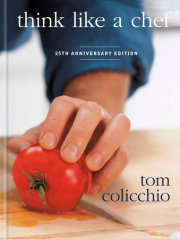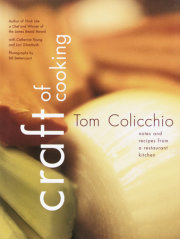My partner at Gramercy Tavern, Danny Meyer, likes to say that the best way to get people to try something new is to let them know it is roasted. The term manages to conjure comfort food and adventurous cooking simultaneously, along with an image of gorgeously browned edges and caramelized flavor. Lamb, beef, pork, venison, rabbit, squab, chicken and turkey, foie gras, whole fish, fish fillets, lobster, almost every vegetable: you name it, I roast it.
Roasting, simply put, is cooking with dry heat, traditionally over or in front of an open flame. Most often, the word "roast" implies oven cooking, but I use the word as shorthand for both oven roasting and pan roasting. They are both the exact same technique, but oven roasting, as the name implies, involves transferring the pan to a hot oven to complete the process. Pan roasting finishes the food in the same pan, on top of the stove.
As a rule, I prefer pan roasting. It allows me to effect a transformation on something almost immediately. Roasting in an oven cheats me of the audible, visual, and tactile cues that are such a gratifying step of the cooking process. For some people, the end result alone--the perfectly browned sea bass, the crisp chicken--is the point, but for me the process of browning the meat, watching the sugars in the surface caramelize, and listening to the sizzling sound of the butter, the sputter as the moisture in the herbs meets the juices in the pan, is as satisfying as the result. Watching as the dish transforms from a group of separate, inert ingredients into a new thing altogether is rewarding even before the first bite. When you learn to pan roast for yourself, a practical benefit is that in time you'll come to recognize the audible and visual cues of correctly cooked food, and you'll find yourself relying less and less on the times and temperatures printed in any recipe.
If I had all day I imagine I'd even cook larger roasts this way. But I don't, and neither do you. Transferring a large piece of meat or fish to the oven allows you to complete the process without standing for hours next to the stove, turning the food. That is not to say that you can transfer a roast to the oven and forget about it. You can't. Even in the oven, the surface that is in contact with the hot pan will roast more quickly than the rest, and the food still needs to be basted. But, loosely speaking, oven roasting allows you to free up the stovetop and yourself (somewhat) to work on something else.
Basic roasting technique
These steps apply to pan roasting and oven roasting alike.
1.Brown the food on top of the stove, in a pan with a small amount of oil, at about medium heat. Browning helps to get the cooking started, moves the juices toward the center of the roast, and ensures a nicely cooked exterior. Don't worry about the food sticking to the pan during this step. If you pat it completely dry first, use only medium or medium-high heat, and be patient, the food will release itself from the pan when it's browned. You'll know when you've attained the correct heat by the "sound" of the pan: The oil should sizzle, but not pop and sputter, as the food cooks.
2.Avoid using high heat, both on the stove and in the oven (temperatures of 325° F. to 375° F. usually work best). Although it is tempting to roast at a high heat, you'll get the best results in terms of flavor and texture by treating the ingredients gently. Contrary to what many recipes say, you do not need to start the oven at a higher temperature, then lower it halfway through.
3.Add some butter to the pan about three-quarters of the way through cooking. It will melt quickly and commingle with the juices from the roast, creating a liquid for basting. This is usually when I add some herbs to the pan. Baste the roast with the liquids in the pan.
4.Let the food rest. The juices will have been forced to the center by the heat. During the resting period they will have a chance to redistribute themselves. If you've properly basted the roast, the outer flesh will have no problem reabsorbing these juices. You can omit this step for fish and vegetables.
It only seems complicated on the page. In practice it is anything but. Just keep repeating to yourself: Brown, gently roast, baste, rest. This same technique works equally well for foods we don't explicitly cover in this chapter--like venison or pork. The only thing that differs is length of time the food cooks until done. Fish obviously takes less time, as do thinner cuts or single portions of meat. Aha! you're thinking. That's why I need a recipe. To know when it's done! But actually, there are a number of ways to test for doneness. You might find it easiest to use a meat thermometer to see if you've achieved the temperature you like (see the box on page 34) or you can pierce it with a knife and see if the juices run clear. A trick I especially like for large cuts of meat is to stick a long metal skewer completely through the roast, leave it there for a moment, then pull it out and press it against my upper lip. If it feels warmer than my skin, I know that the center of the roast is approaching medium rare (125° F.).
If you do rely on a meat thermometer, make a habit of pressing the meat or fish with your finger once it's done and noticing the resistance you feel. If you like your food rare, there should be plenty of "give" to the flesh. At medium, you will be able to press down, but there will be some underlying firmness as well. At well done, the meat will be quite firm, without much give at all. Try to remember the feel of food cooked the way you like it. Eventually you will be able to rely on this tactile method, and you may be able to do away with the thermometer altogether.
Vegetables are cooked through when they are pierced easily with the tip of a knife. Guidelines for fish are hard to give here, since people vary widely on how they like their fish cooked. Usually, when fish turns opaque, it is cooked through. (I like it when it still has a touch of translucence, except in the case of very meaty fish, such as tuna, which I like seared on the edges and rare in the center.) Try to take fish out of the pan a few moments before it's done, as it will continue to cook on its own.
The recipes that follow have suggested cooking times. Please remember, a recipe can't take into account variables like size and thickness of the food, or variations in oven temperature. Even if you can control your oven's temperature with an oven thermometer, a recipe's cooking time should serve as a general guideline only. Check the food earlier than the recipe states and keep checking until it's done.
Roasted Chicken
Serves 4
1 (3- to 3½-pound) free-range chicken
Kosher salt and freshly ground black pepper
2 sprigs of fresh rosemary
2 sprigs of fresh thyme
1 tablespoon peanut oil
2 tablespoons unsalted butter
Coarse sea salt
1. Heat the oven to 375° F. Rinse the chicken and dry thoroughly with paper towels. Cut off the last joint of the wing and discard. Season the chicken liberally inside and out with kosher salt and pepper, place the rosemary and thyme inside the cavity, then truss.
2. Heat the oil in a large, heavy ovenproof skillet over medium heat until it moves easily across the pan. Place the chicken on its side in the skillet and brown, about 7 minutes. Turn and brown the other side, about 7 minutes more. Place the chicken breast-side up and transfer the skillet to the oven. Roast for about 20 minutes, then add butter. Continue roasting, basting occasionally, until the thigh juices run clear, about 30 minutes more. Remove the chicken from the oven and cover loosely with aluminum foil. Allow the chicken to rest for 10 to 15 minutes, then carve and serve sprinkled with coarse sea salt.
Trussing a Chicken
The classic method of trussing a chicken involves sewing the bird shut with a trussing needle and twine. I prefer the simpler method of tying the bird's cavity shut without sewing.
To begin, cut a long piece of butcher's twine (available in most supermarkets), about
3 feet long, and loop the center around the narrowest part of each leg (the "ankles"), pulling the ends tightly to bind the legs together. Bring both ends of twine along the breast, nestling it between the breast and the legs, go around the outside of the wings with each end of the twine, then draw the string up to the nub at the chicken's neck. Cross the ends of the string over the nub. Holding both the strings and the nub, turn the bird over onto its breast. Tie the ends of the string into a tight knot at the nub of the neck.
Copyright © 2000 by Tom Colicchio. All rights reserved. No part of this excerpt may be reproduced or reprinted without permission in writing from the publisher.







